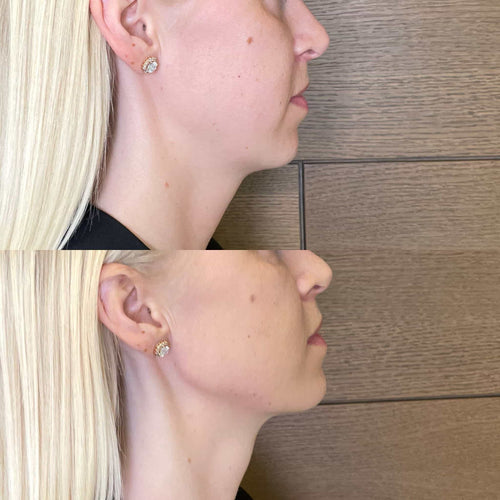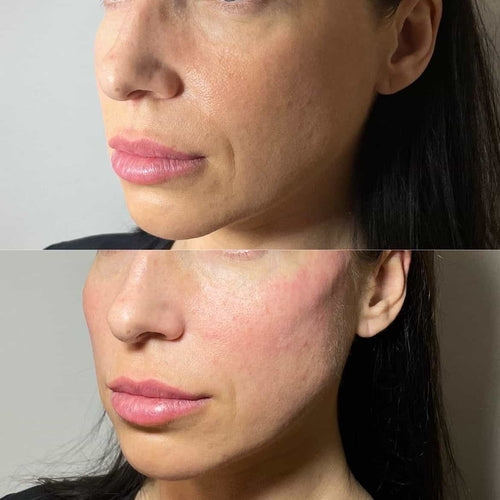What Hurts Worse Botox Or Filler?
May 31, 2025
Schedule Your Dermal Filler Appointment with Dr. Laura Geige Today
Botox: The Muscle Relaxer
How Botox Works
Botox, derived from botulinum toxin, is a neurotoxin produced by the bacterium Clostridium botulinum. It works by blocking nerve signals to muscles, causing temporary paralysis.
When injected into a muscle, Botox prevents acetylcholine, a neurotransmitter, from being released. Acetylcholine is responsible for transmitting signals from nerves to muscles, triggering muscle contraction.
By inhibiting acetylcholine release, Botox effectively paralyzes the targeted muscle. This relaxation of the muscle smooths out wrinkles and fine lines caused by repeated muscle contractions, leading to a more youthful appearance.
The effects of Botox typically last for 3-6 months, after which the body naturally breaks down the toxin and the muscles regain their ability to contract.

It’s important to note that while Botox is effective at reducing wrinkles, it does not address underlying skin laxity or volume loss.
The Pain Factor of Botox
Botox, a neurotoxin derived from the bacterium Clostridium botulinum, works by temporarily paralyzing muscles. It achieves this by blocking the nerve signals that stimulate muscle contractions.
While Botox is renowned for its cosmetic applications in smoothing wrinkles and fine lines, it also possesses therapeutic uses for treating medical conditions such as migraines, excessive sweating, and muscle spasms.
Regarding the pain associated with Botox injections, it’s generally described as a mild to moderate stinging or pricking sensation, akin to a mosquito bite.
Book a Dermal Filler Session with Dr. Laura Geige Today
The actual pain level can vary depending on individual pain tolerance, the number of injection sites, and the specific area being treated. Some individuals may experience a slight tenderness or bruising at the injection site afterwards.
To minimize discomfort, practitioners often apply topical anesthetic cream to the area prior to injections. They may also utilize very fine needles and administer the Botox slowly to reduce any pain.
Overall, most people find that the pain associated with Botox injections is manageable and well worth the desired cosmetic or therapeutic results.
Dermal Fillers: Plumping Up the Volume
Types of Dermal Fillers
Dermal fillers are a popular cosmetic procedure used to restore volume and reduce the appearance of wrinkles, folds, and fine lines. They work by injecting gel-like substances into the skin, plumping it up and smoothing out imperfections.
The level of pain associated with dermal filler injections can vary depending on several factors, including individual pain tolerance, the type of filler used, the injection site, and the experience of the practitioner.
Generally, the sensation during a filler injection is often described as a sharp prick or stinging, similar to a mosquito bite. Some patients may also feel pressure or a stretching sensation as the filler is injected.
Numbness cream is typically applied to the area beforehand to minimize discomfort. During the procedure, ice packs or cold compresses can also be used to further reduce any pain or swelling.
In comparison to Botox injections, which target facial muscles and cause temporary paralysis, dermal fillers address volume loss directly. Therefore, the type of pain experienced can differ.
Botox injections typically involve a series of tiny needles pricking the skin, which may be more numerous and cause a tingling or aching sensation in some individuals.

Filler injections tend to involve fewer needle punctures and the focus is on injecting the gel-like substance, which can result in a sharper but less widespread pain sensation.
Pain Management with Fillers
Dermal fillers are a popular cosmetic procedure that involves injecting gel-like substances into the skin to add volume and fullness. These fillers can be used to address a variety of concerns, including wrinkles, lines, folds, and thin lips.
The most common type of dermal filler is hyaluronic acid, a naturally occurring substance in the body that helps to hydrate and plump the skin. Hyaluronic acid fillers are reversible, meaning they can be dissolved if needed. Other types of fillers include poly-L-lactic acid (PLLA) and calcium hydroxylapatite (CaHA), which stimulate collagen production for longer-lasting results.
The procedure involves injecting the filler into specific areas using a fine needle. The amount of discomfort varies depending on individual pain tolerance and the area being treated. Some people experience mild stinging or pressure, while others may feel more significant pain.
Pain management during filler injections can be achieved through various methods. Topical anesthetic creams applied to the skin prior to injection can help numb the area. Ice packs placed before and after the procedure can also reduce discomfort. In some cases, a local anesthetic may be injected alongside the filler.
Arrange Your Dermal Filler Consultation with Dr. Laura Geige at It’s Me and You Clinic
The duration of pain relief depends on the type of anesthesia used and individual factors. Topical creams typically provide temporary relief for a few hours, while local anesthetics can last longer. Pain management strategies are often tailored to the patient’s needs and comfort level.
It is important to choose a qualified and experienced injector who uses high-quality products and follows proper safety protocols. Open communication with the injector about pain concerns is crucial to ensure a comfortable and satisfactory experience.
Comparing the Discomfort: Botox vs. Fillers
Individual Pain Tolerance
Both Botox and fillers are popular cosmetic procedures with the goal of enhancing appearance. However, they work differently and involve distinct injection techniques, which can lead to varying levels of discomfort for individuals.
Botox involves injecting a neurotoxin into muscles to temporarily paralyze them, reducing wrinkles caused by repeated contractions. The injections are typically administered using a very fine needle and involve minimal tissue disruption. Discomfort during Botox injections is often described as a brief pinch or stinging sensation. Some people may experience mild bruising or swelling at the injection site, but these side effects are usually temporary.
Fillers, on the other hand, involve injecting substances like hyaluronic acid into the skin to plump up areas, smooth wrinkles, and enhance facial contours. The needles used for fillers are generally thicker than those used for Botox. The discomfort level during filler injections can vary depending on factors such as the size of the area being treated, the type of filler used, and individual pain tolerance.
Some individuals find filler injections more uncomfortable than Botox because the larger needles penetrate deeper into the skin. The sensation is often described as a pressure or aching feeling during and after the injection.
It’s important to note that pain perception is subjective and varies greatly from person to person. Some people have a higher pain tolerance than others, meaning they may experience less discomfort during both procedures.
Factors like anxiety levels, previous experiences with injections, and individual skin sensitivities can also influence the perceived level of pain.
Ultimately, the best way to determine which procedure is more comfortable for you is to consult with a qualified and experienced practitioner who can assess your specific needs and provide personalized advice.
Treatment Area Sensitivity
Comparing the discomfort levels between Botox and fillers can be subjective, as individual pain tolerances vary widely. However, there are some general trends regarding treatment area sensitivity.
Botox Injections:
- Generally considered less painful than filler injections.
- The needles used for Botox are very fine and typically only penetrate the top layers of skin, making the sensation akin to a tiny mosquito bite or pinch.
- Pain can be more pronounced in areas with thinner skin, such as around the eyes.
Filler Injections:
- Often described as feeling like a pinching or stinging sensation.
- The needles used for fillers are slightly thicker than those for Botox, and the filler material itself can cause some pressure or discomfort.
- Sensitivity varies depending on the specific area being treated. Lips and cheeks tend to be more sensitive than other areas.
Treatment Area Sensitivity:
- Facial Muscles (Botox): Forehead, frown lines, crow’s feet, and sometimes the neck are common areas for Botox injections. These muscles may feel slightly tender or sore after treatment but usually subside within a day or two.
- Lips (Fillers): Lips are often more sensitive to injections due to their thin skin and rich blood supply. Some patients may experience swelling, bruising, or discomfort that can last for a few days.
- Cheeks (Fillers):** Cheeks have relatively superficial fat deposits, making them less painful than deeper areas but still somewhat sensitive.
It’s important to note that topical anesthetics and other pain management techniques can be used to minimize discomfort during both Botox and filler procedures. Discuss your concerns with a qualified healthcare professional to determine the best approach for you.
Cleveland Relationship Therapy Super Sleep Yoga On the Carpet James Martin Live Fashionably Balanced
- Troubleshooting Voltage Issues On The Craftsman Series Vape - December 26, 2025
- Traptox Aka Trapezius Botox Treatment Near Littleton, Surrey - December 24, 2025
- Traptox Aka Trapezius Botox Treatment Near Ashtead, Surrey - December 21, 2025
